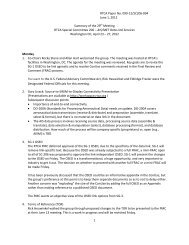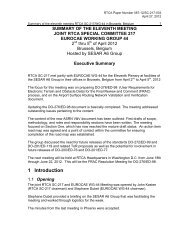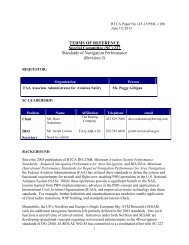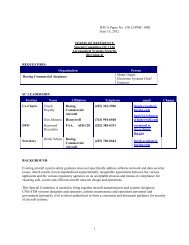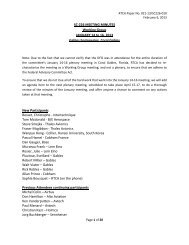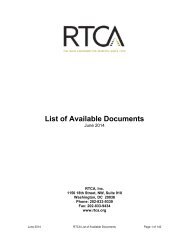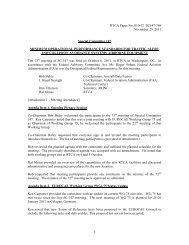Summary of the First Meeting Special Committee 227 ... - RTCA
Summary of the First Meeting Special Committee 227 ... - RTCA
Summary of the First Meeting Special Committee 227 ... - RTCA
You also want an ePaper? Increase the reach of your titles
YUMPU automatically turns print PDFs into web optimized ePapers that Google loves.
o Are <strong>the</strong> ATM operational concepts well enough defined<br />
o Clear that <strong>the</strong>re is some relationship between ground and air systems<br />
Coordination with SC214 / WG78 data comm. standards is needed.<br />
Interim steps to 4D that need to be considered.<br />
o Enhanced time-based flow mgmt<br />
o Use <strong>of</strong> target time <strong>of</strong> arrival<br />
o Part <strong>of</strong> an AMAN/DMAN + collaborative ATM<br />
o Need to provide adequate intent information to <strong>the</strong> ground systems<br />
Perhaps <strong>the</strong> CNS section in DO236 needs to better explain <strong>the</strong> interrelations to o<strong>the</strong>r systems<br />
Help define clearer requirements for 4D requirements and operations<br />
Harmonization with WG85<br />
Need to bring SC214/WG78 into line or accept <strong>the</strong>re may need to be rework<br />
Data quality – DO-200A is a bit dated, perhaps needs to be updated<br />
<strong>Summary</strong><br />
Need all stakeholders, especially controllers, participating.<br />
SC181 History Perspective and Need for FMS Standards – Frank<br />
Alexander<br />
Frank Alexander, IATA, former Co-Chair <strong>of</strong> Joint SC181/WG13.<br />
Powerpoints: “3b SC-<strong>227</strong> History Presentation.pptx “ & “3b FMS standardization presentation.ppt”<br />
Early 1990s observed need for FMSs from disparate suppliers and OEMs to have similar behavior.<br />
December, 1993 was <strong>the</strong> first SC181 meeting. In early 1994, SC181 joined with WG13.<br />
Frank stated that we must try to look forward 20 years to what <strong>the</strong> requirements will be so that we can<br />
define <strong>the</strong> system once now, since upgrade opportunities for airplanes happen seldom. Today’s technical<br />
standards do not incorporate <strong>the</strong> requirements that are needed to insure consistent performance across all<br />
lines <strong>of</strong> FMC.<br />
The main concerns, and areas <strong>of</strong> differences are:<br />
Turn performance variation<br />
Phase <strong>of</strong> flight transitions – variations affect<br />
o roll rates, speeds, default RNP values, display scaling<br />
Dissimilar VNAV path construction<br />
RTA differences<br />
o What are <strong>the</strong> performance numbers<br />
o Acceptable tolerances for ATM<br />
o How is it achieved<br />
o Availability <strong>of</strong> intent<br />
Database coding<br />
o Offsets, dep/app procedures, speed constraints<br />
Holding<br />
o Wide variation in paths for holding patterns<br />
Sylvain: common performance requirements will not allow manufacturers to optimize <strong>the</strong>ir aircraft<br />
performance.<br />
SC181 History Perspective and Thoughts for SC<strong>227</strong> – John Hillier<br />
John Hillier, Honeywell<br />
Powerpoint: “3c SC <strong>227</strong> KOM - Honeywell.ppt”<br />
John led <strong>the</strong> SC-181 path definition subgroup, co-chaired with Airbus’s Gilles DeCevin<br />
John pointed out that RNP RNAV certification now is painful and we need to fix this!<br />
10




